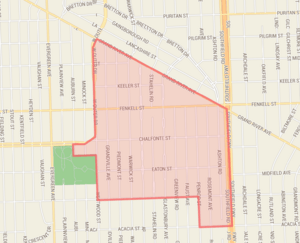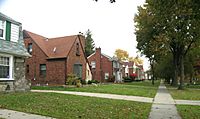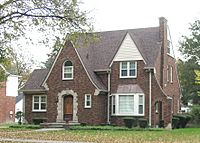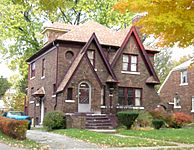Rosedale Park, Detroit facts for kids
Quick facts for kids |
|
|
Rosedale Park Historic District
|
|
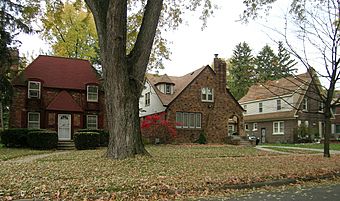
Streetscape on Artesian St.
|
|
| Location | Roughly bounded by Fenkell, Outer Dr. W, Grand River Ave., Southfield Fwy, Glastonbury, Lyndon, Westwood Dr. Detroit, Michigan, U.S. |
|---|---|
| Built | 1916 |
| Architect | Albert Kahn |
| Architectural style | Colonial Revival, Tudor Revival |
| NRHP reference No. | 06000587 |
| Added to NRHP | July 12, 2006 |
Rosedale Park is a special neighborhood in Detroit, Michigan. It's known as a historic district, which means it has many old and important buildings. This area was added to the National Register of Historic Places in 2006.
Rosedale Park is a very large historic district. It has more than 1,500 individual homes! Most of the houses here are made of brick. They were built mostly between the late 1920s and the 1940s.
Contents
Exploring Rosedale Park's Past
The land where Rosedale Park now stands was first owned by two people in 1835. Over time, this land was divided into smaller pieces. In 1916, a company called the Rosedale Park Land Development Company bought a big part of it. They planned out the neighborhood we see today.
This company also developed other areas nearby. One was North Rosedale Park, which is just across Grand River Avenue. The company thought this spot was great for building homes. It was close to Grand River Avenue, which led straight to downtown Detroit. Also, a new road called Outer Drive was being built at the same time.
People were very interested in the new neighborhood right away. In 1917, the company added more land to the original plan. But building homes was slow at first. By the end of World War I, only 15 houses were built.
However, construction soon picked up speed. In 1921, a third section was planned. The city of Detroit officially took over the area in 1926. This meant the neighborhood got water and sewer services, making it even more appealing to families.
Compared to other fancy neighborhoods of that time, like Palmer Woods, Rosedale Park had smaller houses and lots. This was because it was built for middle-class and upper-middle-class families. Many of the first homeowners were professionals. They were doctors, dentists, accountants, or worked in the growing car industry.
When the Great Depression started in 1929, building slowed down. But in 1934, the FHA made it easier to get loans. So, construction started again. The neighborhood grew a lot in the late 1930s and early 1940s. By the 1950s, almost every lot had a house on it.
Even as Detroit's population changed later on, Rosedale Park stayed a popular place to live. This is because it has well-built homes, a nice setting, and a very active neighborhood group.
What Rosedale Park Looks Like
Rosedale Park is mostly a neighborhood with homes. The main streets run from north to south. Large stone pillars mark the main entrances to the area. You can also see traffic islands in the middle of many streets. Big oak and maple trees line the streets. Some of these trees were planted way back in the 1910s and 1920s!
Most homes in Rosedale Park were not designed by famous architects. Instead, buyers often chose plans from books or from what construction companies offered. Between 1917 and 1955, houses were built in many different styles. These included English Tudor Revival, Arts and Crafts, Bungalow, Colonial Revival, and Ranch homes.
The developers seemed to encourage an English country look for the neighborhood. This even influenced the names of many streets, like Glastonbury and Warwick. These names remind people of "Merry Old England." Later homes, built in the 1930s and 1940s, were simpler. They were often Colonial or Ranch styles, but many still had some Tudor Revival touches.
Learning in Rosedale Park
Children living in Rosedale Park go to schools run by Detroit Public Schools.
For elementary school, most students go to Gompers K-8 School. Some areas are zoned for Cooke Elementary School. All middle school students go to Gompers K-8. For high school, students attend Frank Cody High School.
The current Gompers Elementary-Middle School opened in 2011. It's a modern, two-story building. It replaced three older schools and has separate wings for elementary and middle school students.
Gallery


